Bangkok is not only a party metropolis, but also a center of deeply rooted spiritual traditions.
Thailand’s capital, a kaleidoscope of colors and cultures, is home to some of the most breathtaking temples (wats) in all of Southeast Asia.
In this blog post, we show you the most beautiful Bangkok temples, each of which has its own history, architecture and spiritual significance.
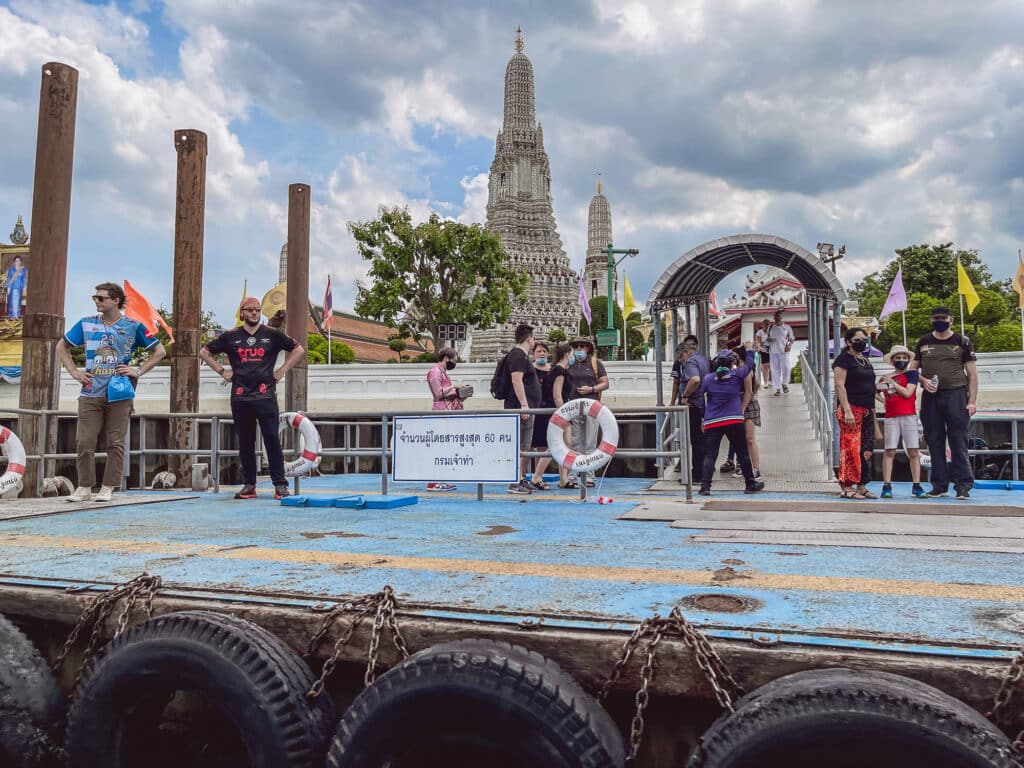
These 10 Bangkok temples are a must for your visit
From the famous Wat Phra Kaeo, home to the emerald green Buddha, to the picturesque Wat Arun on the banks of the Chao Phraya River, Bangkok’s most sacred sites are not only spiritual places, but also witnesses to Thailand’s rich history and art.
Admire the finely crafted mosaics and golden stupas, enjoy the very special atmosphere and immerse yourself in the country’s exciting culture.
Best things to do in Bangkok
And you should definitely not miss these 10 Bangkok temples during your visit to Thailand’s capital:
1st Wat Phra Kaeo (Temple of the Emerald Buddha)
Wat Phra Kaeo, also known as the Temple of the Emerald Buddha, is one of the most important and revered religious symbols in Thailand.
Located in the historic center of Bangkok, within the walls of the Grand Palace, this impressive temple exudes an aura of spirituality.
Built in 1782, during the founding of Bangkok by King Rama I, it serves as the spiritual center of Thai Buddhism.
The centerpiece of the temple is the highly revered statue of the Emerald Buddha, which despite its name is carved from a single piece of jade and is considered the patron saint of Thailand.
This small but impressive statue is known for the three different robes it is dressed in at different times of the year – a ceremony performed personally by the King of Thailand.
Wat Phra Kaeo is not only a place of spirituality, but also a masterpiece of Thai architecture.
The entire complex is richly decorated with colorful mosaics, golden chedis and intricate murals depicting scenes from the Ramakien, the Thai national epic.
The grounds are also lined with a series of impressive buildings and pavilions in traditional Thai design, testifying to the deep religious and cultural significance of the site.
Click here for our detailed article about the Grand Palace.
Tip: Book a guided tour to the Grand Palace and Wat Phra Kaeo to find out more about the Grand Palace.
Getting there: By MRT (Blue Line) to Sam Yot, by ferry to Tha Tien Pier or by cab.
Opening hours: Daily from 08:30 to 15:30.
Admission: 500 baht for adults (as of 2023).
Dress code: Knees and shoulders covered
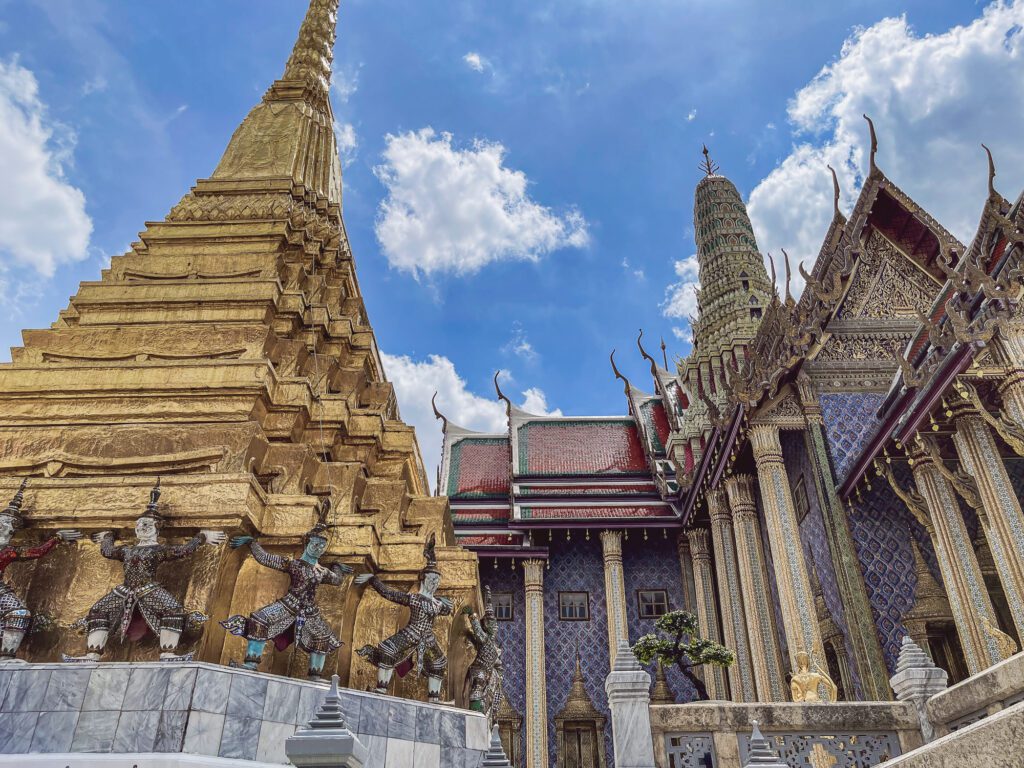
2nd Wat Arun (Temple of the Dawn)
Wat Arun, known as the Temple of Dawn, is one of Bangkok’s most iconic landmarks and one of the most visually stunning spiritual sites in Thailand.
Situated on the western bank of the Chao Phraya River, this majestic temple rises into the sky with its unique architecture and finely decorated towers (prangs).
The main prang, believed to represent the mythical Mount Meru, is decorated with colorful porcelain pieces and sea bowls and is a spectacular sight at sunrise when the first light of day illuminates its façade.
Wat Arun dates back to the Ayutthaya period and was remodeled and expanded in the 19th century under King Rama II and Rama III.
The top of the central Prang can be reached via steep steps, from where visitors can enjoy a breathtaking view over the river and the city.
In addition to the main prang, the temple complex also includes smaller prangs dedicated to the four heavenly guardians in Hindu mythology.
Wat Arun is not only a place of worship, but also a symbol of Thailand’s cultural identity and artistic excellence.
Its breathtaking beauty and deep spiritual significance make it an absolute must-see on any trip to Bangkok.
Here you can find our detailed article about Wat Arun.
Getting there: By MRT (Blue Line) to Itsaraphap, by ferry to Tha Tien Pier or by cab.
Opening hours: Daily from 08:00 to 18:00.
Admission: 100 baht for adults (as of 2023).
Dress code: Knees and shoulders covered
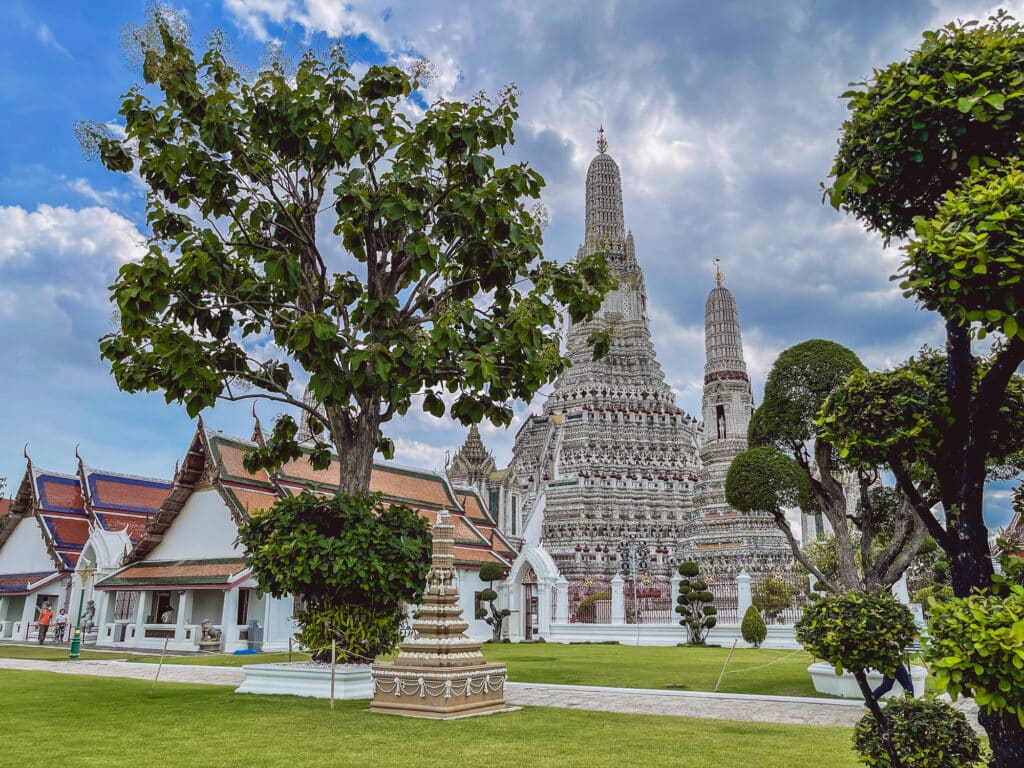
3. Wat Pho (Temple of the Reclining Buddha)
Wat Pho, officially known as Wat Phra Chetuphon Vimolmangklararm Rajwaramahaviharn, is one of the oldest and largest temple complexes in Bangkok.
It is particularly famous for its gigantic reclining Buddha statue, which is one of the largest of its kind in Thailand at 46 meters long and 15 meters high.
The statue, which depicts the Buddha at the moment of entering Nirvana, is completely covered in gold leaf and impresses with the artistically designed mother-of-pearl inlays on the feet.
In addition to the reclining Buddha statue, Wat Pho is home to an impressive collection of more than a thousand Buddha statues brought together from various parts of Thailand.
The temple complex itself is a labyrinth of colorful chedis (stupas), beautiful pavilions and a lush garden.
Wat Pho is also known as the center of traditional Thai medicine and massage. It is considered the birthplace of Thai massage and offers both training in this art and relaxing massage treatments for visitors.
Here you can find our detailed article about Wat Pho.
Tip: This private tour to the city’s most important temples also takes you to Wat Pho.
Getting there: By MRT (Blue Line) to Sam Yot (about 20 minutes walk), by ferry to Tha Tien Pier or by cab.
Opening hours: Daily from 08:30 to 15:30.
Admission: 100 baht for adults (as of 2023).
Dress code: Knees and shoulders covered
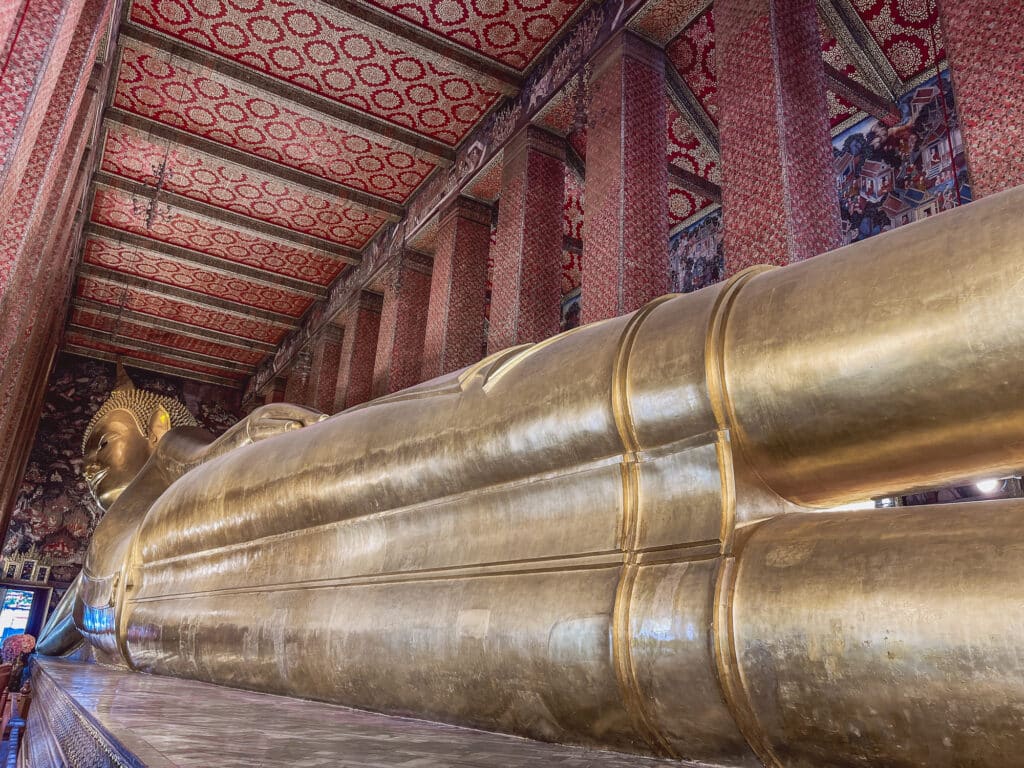
4th Wat Saket (Golden Mount)
Wat Saket, better known as the Golden Mount, is a historical and artistic masterpiece in Bangkok.
The temple, which was built on an artificial hill, offers a unique blend of spiritual significance and breathtaking views.
The most striking structure of Wat Saket is the golden chedi at the top of the hill, which makes the temple visible from afar and gives it its nickname.
The ascent to the Golden Mountain leads over 300 steps that spiral upwards.
During the ascent, visitors are surrounded by gardens, waterfalls and traditional bells that create an almost meditative atmosphere.
Once you reach the top, you are rewarded with a panoramic view of Bangkok’s skyline. The platform around the golden chedi is a popular place to meditate, pray and make offerings.
Wat Saket also plays an important role during the annual Loi Krathong festival, when thousands of worshippers visit the temple to take part in religious ceremonies and light candles.
How to get there: By MRT (Blue Line) to Sam Yot (approx. 15 minutes on foot), by ferry to Panfa Leelard Pier or by cab.
Opening hours: Daily from 07:30 to 19:00.
Admission: 100 baht for adults (as of 2023).
Dress code: Knees and shoulders covered
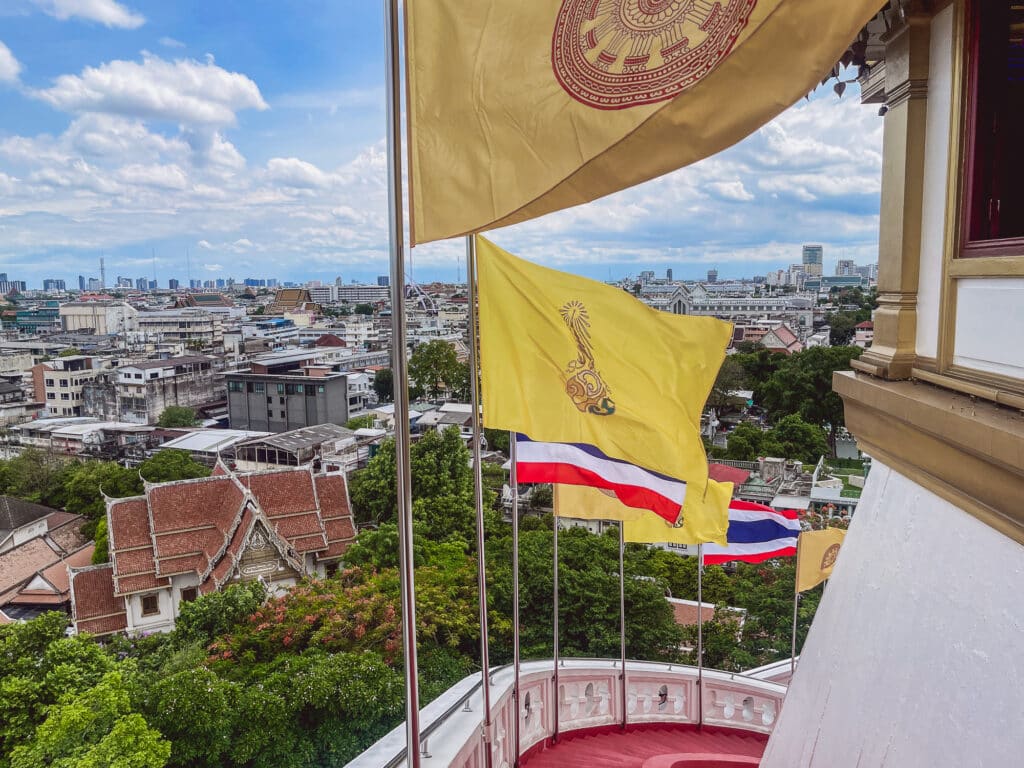
5th Wat Traimit (Temple of the Golden Buddha)
Wat Traimit, also known as the Temple of the Golden Buddha, is an impressive landmark in Bangkok, famous above all for its remarkable Buddha statue made of pure gold.
This statue, which is almost 5 meters high and weighs around 5.5 tons, is a great example of Buddhist art and is considered to be the largest solid gold statue in the world.
The story of the Golden Buddha, or Phra Phuttha Maha Suwana Patimakon, is almost as fascinating as the statue itself.
For centuries, the statue was hidden under a layer of stucco to protect it from thieves.
It was not until the 1950s, when it was accidentally dropped, that the valuable gold came to light.
The temple, which is located in the Chinatown district of Bangkok, attracts a large number of visitors and worshippers every day who come to admire the statue and pay their respects.
In addition to the main attraction, Wat Traimit also has a museum that presents the fascinating history of the Golden Buddha and the rich culture of Thailand.
Tip: This guided tour through Chinatown shows you the most exciting corners of the district.
How to get there: By MRT (Blue Line) to Hua Lamphong, by ferry to Hua Lamphong Pier or by cab.
Opening hours: Daily from 08:00 to 17:00.
Admission: Museum: 100 baht for adults, statue: 40 baht for adults (as of 2023).
Dress code: Knees and shoulders covered
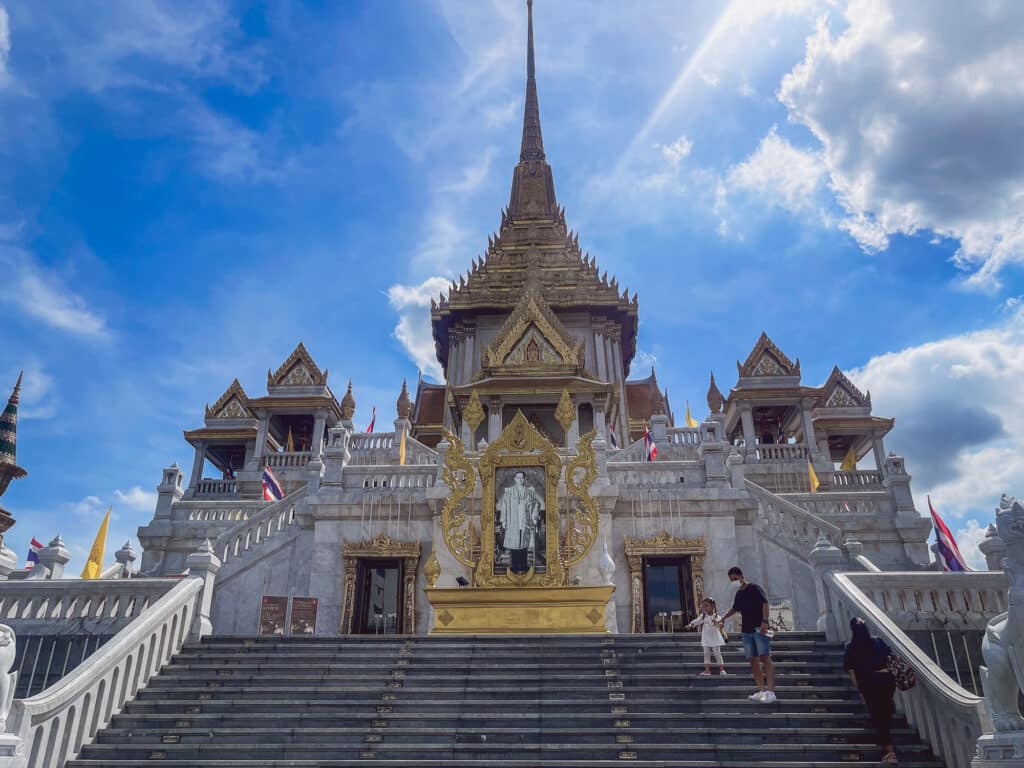
6th Wat Benchamabophit (marble temple)
Wat Benchamabophit, better known as the Marble Temple, is one of the best examples of Thai temple architecture in Bangkok.
Built at the end of the 19th century under King Chulalongkorn (Rama V), the temple stands out for its use of white Carrara marble from Italy, which gives it its nickname and radiant appearance.
The architecture of Wat Benchamabophit is a fascinating fusion of traditional Thai design and European influences.
The central ubosot (ordination hall) is surrounded by a crescent-shaped courtyard with a beautiful garden and 52 different Buddha statues representing various postures and styles from all over Thailand and other Buddhist countries.
Inside the ubosot is an impressive seated bronze Buddha from the Sukhothai period, which was donated by King Chulalongkorn himself.
The walls and ceilings are richly decorated with ornate paintings depicting religious stories and spiritual scenes.
The Bangkok temple Wat Benchamabophit is not only a popular destination for tourists, but also an active religious site where ceremonies and meditation sessions are held regularly.
Tip: This private temple tour takes you to Wat Pho, Wat Traimit and Wat Benchamabophit.
How to get there: By ferry to Ratchadamnoen Nok Pier or by cab.
Opening hours: Daily from 08:00 to 17:30.
Admission: 50 baht for adults (as of 2023).
Dress code: Knees and shoulders covered
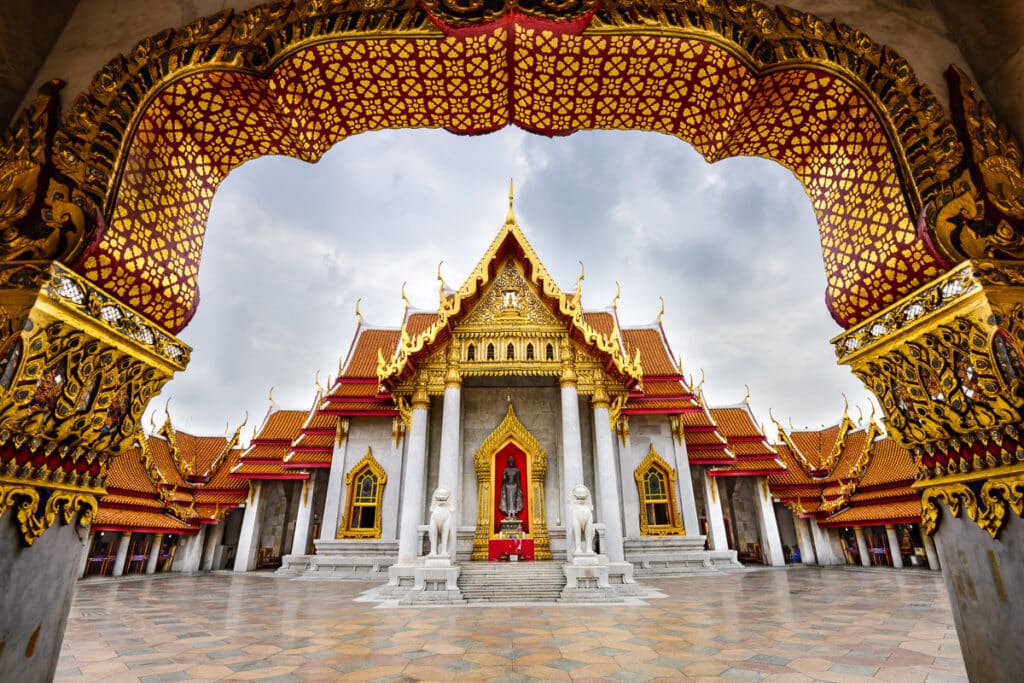
7th Wat Suthat
Wat Suthat, one of Bangkok’s oldest and most impressive temples, is famous for its architectural elegance and profound spiritual significance.
Construction of the temple began in the early Rattanakosin era under King Rama I and was completed under King Rama III.
It is one of the few temples in Bangkok to have survived three royal reigns, which underlines its historical and cultural significance.
At the center of the temple is the magnificent main Buddha, known as Phra Sri Sakyamuni, which dates back to the 13th century and was brought to Bangkok from Sukhothai.
The halls of Wat Suthat are surrounded by beautifully detailed murals depicting scenes from the life of Buddha and Ramakien, the Thai national epic.
Another characteristic feature of Wat Suthat is the huge red swinging beam, known as the Giant Swing, which stands in front of the temple.
This historic landmark, which was once part of a Brahmin ritual, has become an iconic symbol of Bangkok.
Wat Suthat, less crowded than other temples in the city, offers visitors an atmosphere of tranquillity and spirituality.
How to get there: By MRT (Blue Line) to Sam Yot or by cab.
Opening hours: Daily from 08:00 to 21:00.
Admission: 100 baht for adults (as of 2023).
Dress code: Knees and shoulders covered
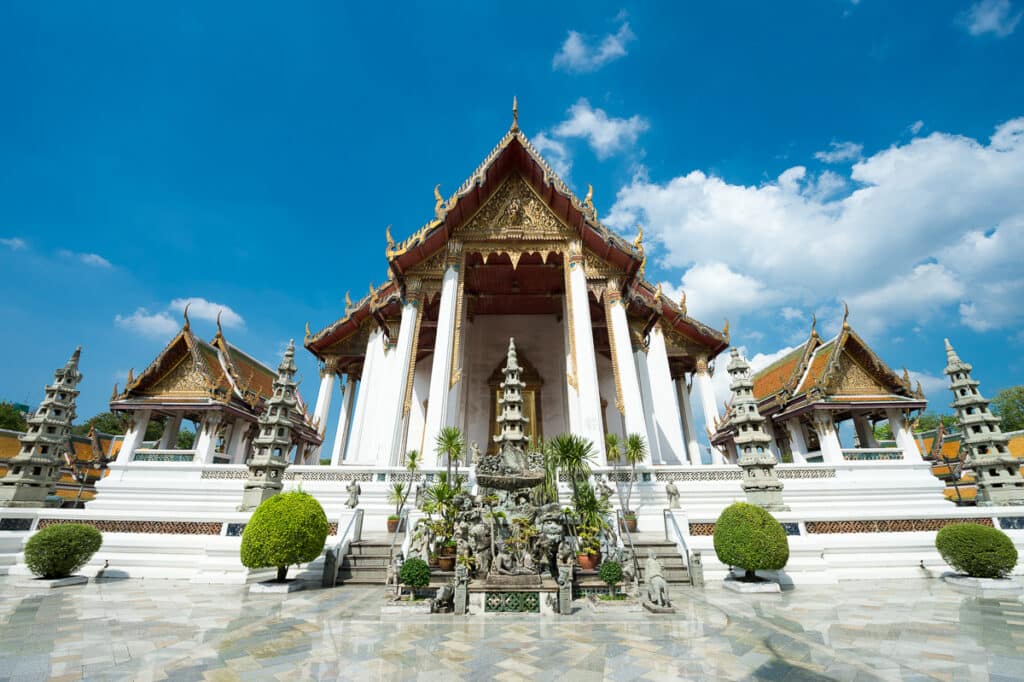
8th Wat Ratchanatdaram
Wat Ratchanatdaram, an architecturally unique temple in Bangkok, offers visitors a fascinating combination of spiritual significance and historical backdrop.
Built in the 1840s under King Rama III, the temple is particularly famous for the Loha Prasat, the “metal palace”, a multi-storey building with 37 metal spires symbolizing the 37 virtues for enlightenment in Buddhism.
The Loha Prasat is unique in the world and the only one of its kind that still exists. It consists of several concentric squares built around a central tower.
Each square is covered with small chedis and connected by a labyrinth of corridors.
Visitors can explore the different levels that lead to a viewing platform from which you have a great view of the historic parts of Bangkok.
Wat Ratchanatdaram is also known for its beautiful architecture in traditional Thai style and its calm, meditative atmosphere.
Despite its proximity to the bustling city center, the temple offers a place of peace and is an oasis of contemplation.
Tip: You can escape the hustle and bustle of Bangkok on a day trip – for example to the temples of Ayutthaya.
How to get there: By MRT (Blue Line) to Sam Yot (approx. 15 minutes on foot), by ferry to Panfa Leelard Pier or by cab.
Opening hours: Wednesday to Monday from 09:29 to 21:44, closed on Tuesday
Admission: 20 baht for adults (as of 2023).
Dress code: Knees and shoulders covered
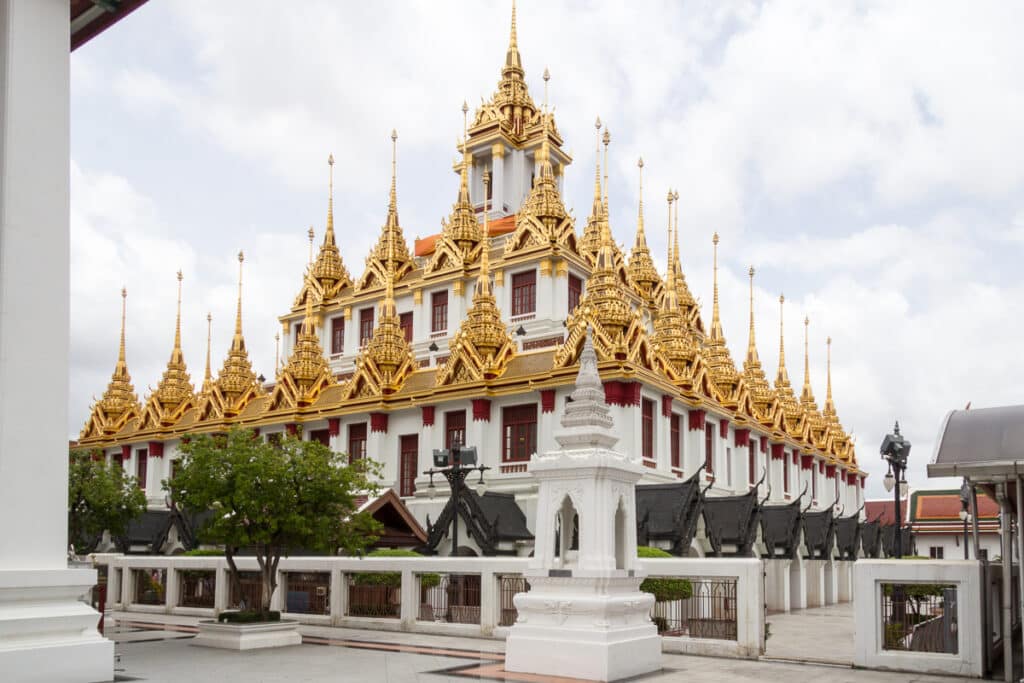
9th Wat Mahathat Yuwaratrangsarit
Wat Mahathat, located in the heart of the historic city of Bangkok, is one of the oldest and most important temples in Thailand.
Known for its deep spiritual significance, the Bangkok temple Wat Mahathat plays a central role in Thai Buddhism and serves as the headquarters of the Mahanikai school of Theravada Buddhism.
The temple, whose full name is “Wat Mahathat Yuwaratrangsarit”, was built in the 18th century during the Ayutthaya period and has undergone several renovations over the years.
It is famous for its elegant chedis and viharns, which are designed in the traditional Thai architectural style.
One of the main attractions of the temple is the “Phra Viharn Luang”, the large ordination hall, which houses impressive Buddhist works of art.
Wat Mahathat is also known as a center of meditation and offers regular courses in Vipassana meditation, which are open to both locals and tourists.
In addition, the temple complex houses the Center for the Study of Buddhism and Thai Traditions, making it an important place for education and spiritual practice.
How to get there: By MRT (Blue Line) to Sanam Chai (approx. 20 minutes on foot), by ferry to Tha Chang Pier or by cab.
Opening hours: Daily from 08:00 to 17:00.
Admission: Free (as of 2023).
Dress code: Knees and shoulders covered
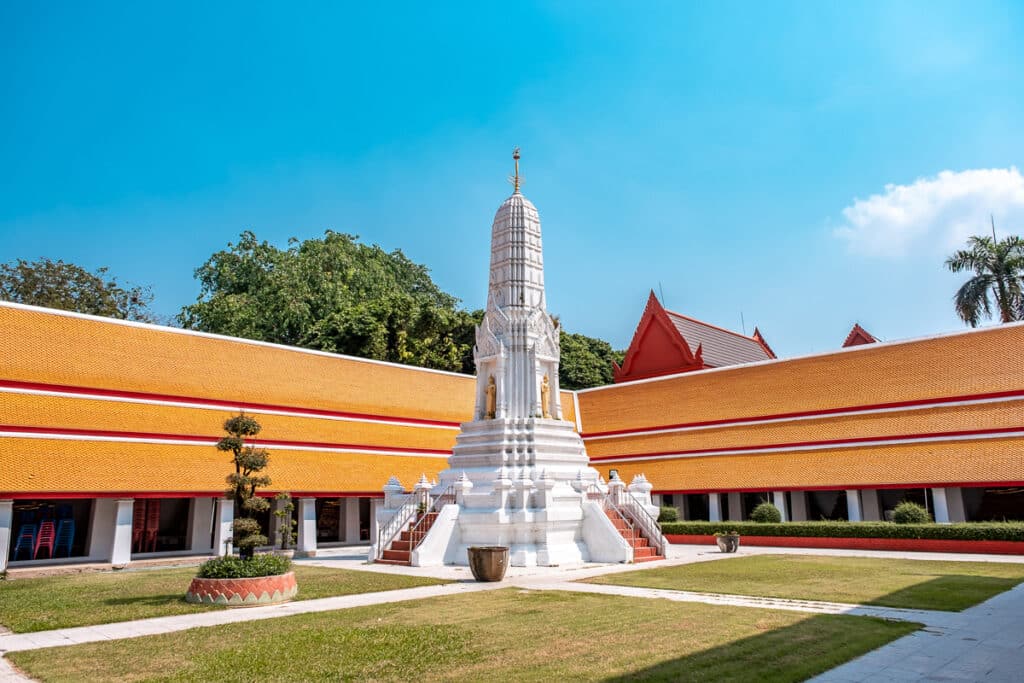
10th Wat Ratchabophit
Wat Ratchabophit, located in the historic old town of Bangkok, is an extraordinary temple that impresses with its unique architecture and artistic design.
Built at the end of the 19th century under King Rama V, this temple impressively combines traditional Thai and neoclassical European architectural styles.
The central chedi of Wat Ratchabophit, richly decorated with colorful tiles and gilded elements, is a true work of art and a striking feature of the temple.
The ordination hall (ubosot) is known for its round shape, a rarity in Thai temples, and for the detailed murals depicting both Buddhist and secular scenes.
Another notable feature of Wat Ratchabophit is the row of altars that line the walls of the main building, showing various Buddha statues in different postures.
The temple also houses a royal cemetery, where some members of the royal family are buried, and is characterized by its magnificent mosaic-decorated towers.
Tip: Book a guided tour to the main sights of the city to learn more about the history of Bangkok.
How to get there: By MRT (Blue Line) to Sam Yot or by cab.
Opening hours: Daily from 06:00 to 18:00.
Admission: Free (as of 2023).
Dress code: Knees and shoulders covered
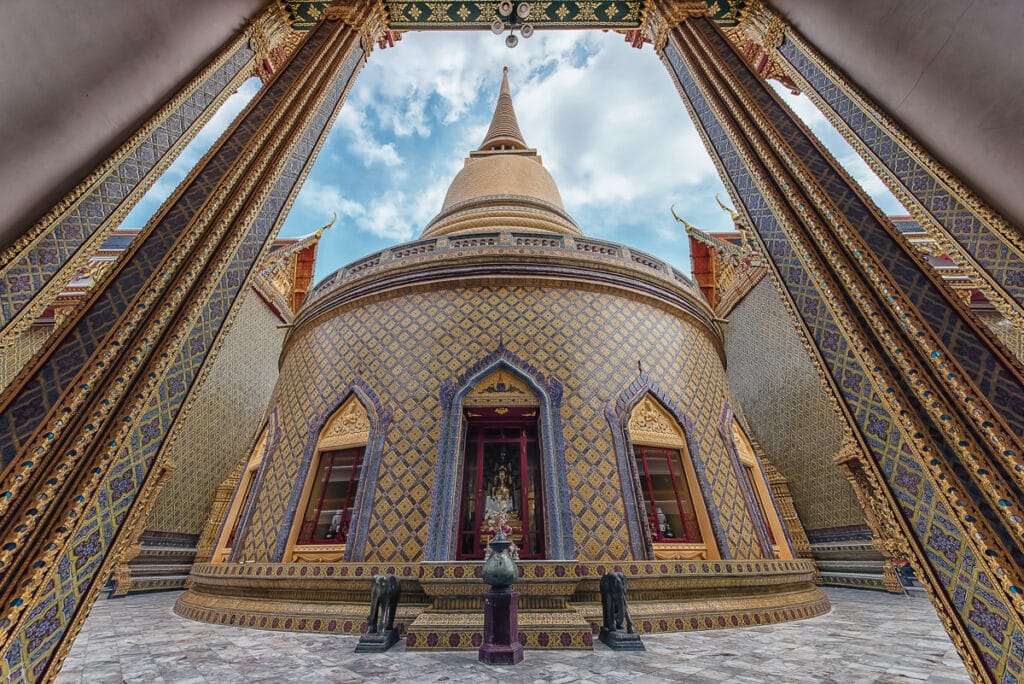
Frequently asked questions about Bangkok temples
Finally, we will answer some frequently asked questions about Bangkok temples.
Which are the most famous Bangkok temples?
The most famous temples in Bangkok are Wat Phra Kaeo, Wat Arun, Wat Pho and Wat Saket.
Is there a dress code to visit the Bangkok temples?
Yes, appropriate clothing is required. Shoulders and knees should be covered and shoes must be removed when entering some buildings.
Is there an entrance fee to the temples in Bangkok?
Some Bangkok temples, such as Wat Phra Kaeo and Wat Pho, charge an entrance fee, while others such as Wat Arun and Wat Saket only charge a small fee. Some temples are free of charge, only donations are requested.
What is so special about Wat Phra Kaeo?
Wat Phra Kaeo is famous for the statue of the Emerald Buddha and its magnificent architecture. It is located in the large palace complex.
Can you take photos in the Bangkok temples?
Photography is permitted in most temples, but often not in the sacred areas or directly in front of the Buddha statues.
When is the best time to visit the Bangkok temples?
Early in the morning or later in the afternoon are ideal for avoiding the crowds and making the most of the great light for photos.
What is unique about the Bangkok temple Wat Pho?
The Bangkok temple Wat Pho is known for its giant reclining Buddha statue and as the birthplace of traditional Thai massage.
Are the temples in Bangkok actively used religious sites?
Yes, they are active religious sites. You will also see monks there and can observe religious ceremonies.

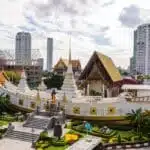
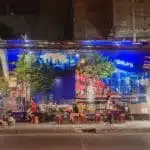
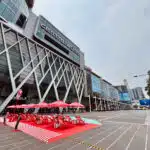
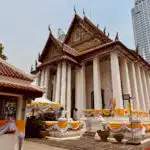
Leave a Reply